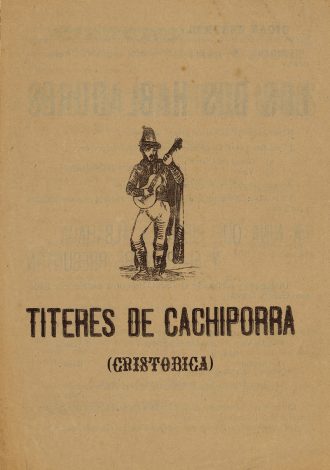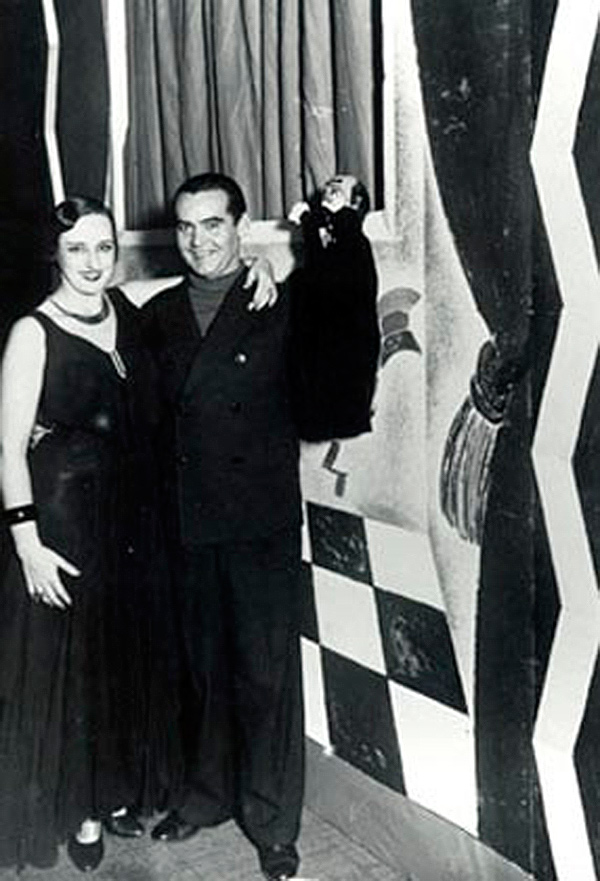
The Billy-Club Puppets (Títeres de cachiporra). Tragicomedy of Don Cristóbal and Doña Rosita. Puppet farce in six scenes and a warning was written in 1922, later revised, but never premiered during Federico García Lorca’s lifetime. As its title indicates, it consists of six scenes and a warning. It begins with the warning put in Mosquito’s mouth and addressed to the audience.
In the first scene Rosita appears embroidering and her father complaining about his financial situation. He proposes to marry her to solve the problem and Rosita is happy believing that the lucky one is going to be her boyfriend Cocoliche. But the father had arranged the marriage with Cristobita, an old brute and despot, with his traditional characteristic cudgel, who buys the girl in exchange for paying off the father’s debt. When Rosita finds out, she is indignant, but ends up accepting the situation.
In the second scene, Cocoliche finds out and is taken to the tavern by some waiters. Meanwhile, Cristobita and the father close the deal. The father feels remorse and doubts to whom he should give his daughter.
In the third scene, they meet a young man in the tavern who had been a former boyfriend of Rosita’s and who left her to go see the world.

In the fourth, Mosquito appears describing how Rosita feels. The young man, Currito, plans to see her taking the place of the shoemaker who is going to try on her wedding shoes.
In the fifth, Cristobita prepares for the wedding and in the sixth scene Rosita complains when Currito, her old boyfriend whom she no longer loves, appears, pretending to be the shoemaker. In Cristobita’s presence, she locks Currito in a closet. Cocoliche also appears through a window and ends up locked in the closet with the other young man. In the end, the existence of the two hidden young men is revealed, Currito ends up with Cristobita and Rosita and Cocoliche are free again to live their love.
Lorca had planned the premiere for the autumn of 1936. That summer, at the beginning of the Civil War, he was assassinated by the pro-Franco side and the work could only be premiered posthumously.
It was premiered in December 1937, at the Zarzuela Theater in Madrid, by a company organized by the Propaganda and Press Department. Performers: Maribel Ramos (el Mosquito), Julia Cominges (Rosita), José Franco (Mr. Cristobita), Mr. Herrero (father), Luis so Horna (Cocoliche), Santiago Rivero (Currito “er der” [of the] Port), Mr. Ortega (Tires-Souls) and Antonio G. Ródenas (Fígaro). Director: Felipe Lluch Garín, replaced in his absence by María Teresa León and Rafael Alberti.
The “definitive” version of the text, from the Tragicomedy, was published by Juan Guerrero Zamora in Raíz. Cuadernos de literatura de la Facultad de Letras, Madrid, 1948. The text comes from an actor’s copy, by José Franco (one of the actors in the 1937 premiere). In Raíz the play is entitled The Billy-Club Puppets. Farsa guiñolesca en seis cuadros (Puppet farse in six scenes). Aguilar will later add “and a warning”.
Lorca had been thinking of writing about these characters since the summer of 1921. In Madrid he had talked with Salazar about the possibility of collaborating in an attempt to revive this popular tradition. In Asquerosa (Disgusting), he inquires among the neighbors about that popular theater (as a child, in Fuente Vaqueros he had been fascinated by this popular theater). Thanks to the memory of the elderly locals, he recovers characters.
This is the starting point of the The Billy-Club Puppets that he was to finish the following year. In 1922, the family spends the summer, as usual, in Asquerosa and on August 5, Federico finishes the draft of his farce. This is the time of collaboration with Falla, research in popular genres and the organization of the Cante Jondo (Deep Song) Contest. In addition to the type of theater and typical characters, he also uses popular songs and witty dialogues typical of the peasants of the Vega de Granada. As he stated in a letter, he had planned to take a puppet theater to the villages of the Alpujarra with Falla. Later this manuscript was to be reworked.
1922 is the date of the manuscript in the archive of the García Lorca Foundation, although there were probably other manuscripts, some earlier and several later ones. The manuscript version is not the definitive version. Lorca revised it later with a view to its premiere. He made arrangements with Martínez Sierra in 1924; with Rivas Cherif in 1926; he intended to publish it together with Love of Don Perlimplin and Belisa in the Garden in 1928. In 1932, he thought of Margarita Xirgu and the collaboration of La Argentinita. In October 1933, he considered it finished, seeing it as a “rare work” with lyrics and music of his own and planned to premiere it in Cadiz. He worked on the piece during his stay in Montevideo. In 1935, he commissioned the sculptor Ángel Ferrant to make the heads of the puppets and he announced its premiere with music by Federico Elizalde in a Barcelona newspaper on his return from Mexico. During the spring of 1935, in Barcelona, he rehearsed with Elizalde on the piano of the Hotel Majestic. It seems that he contacted Carmen Díaz’s company for the premiere (a ballet, according to La Argentinita).
In 1923, there was an experience with puppets, on January 6, the day of the Three Kings, in his house on the Acera del Casino in Granada, in a private party staged by Lorca, Manuel de Falla and Hermenegildo Lanz for the children. On that occasion, among other pieces, a Lorca adaptation of the Andalusian tale The girl who waters the basil was performed.
On March 26, 1933, in Buenos Aires, in a farewell party to the city, Lorca mounted the Retablillo (Puppet Play) of Don Cristóbal (written in 1930) for his friends there, in an extraordinary performance, at the entrance of the Avenida theater, at dawn, with costumes and sets by Fontanals and puppets by Arancibia. Later on, there was a performance in 1934 by La Barraca, in Spain.
Although the Puppet Play derives from the Tragicomedy, it recovers some features of the traditional farce, far from the classic dramatic form of the first version, even incorporating the spectator in the dynamics of the scene and simplifying the plot and number of characters..
The little theater represents an Andalusian village square. On the right, the house of Señora Rosita. There should be an enormous palm tree and a bench. Cocoliche appears on the left, hovering, with a guitar in his hands and wrapped in a dark green cape with black agremanes. He is dressed in the popular costume of the beginning of the 19th century, and he is wearing his little hat from Calañas graciously.
COCOLICHE. Rosita does not go out. She is afraid of the moon. The moon is terrible for a lover of occultism. (Whistles.) The whistling played like a pebble of music on the glass on her balcony. Yesterday she put a ribbon in her hair. She said to me: A black ribbon in my hair is like snacking on fruit. Be sad if you see me; the black will then go down to my feet. Something is wrong with her.
(The little balcony full of pots is illuminated with a sweet light…)
ROSITA (inside)
Fort the vito, vito, vito,
For the vito I can die.
COCOLICHE. (Coming closer.) Why didn’t you go out?
ROSITA. (On the balcony very corny and very poetic.) Oh my little boy! The Moorish wind now turns all the weather vanes of Andalusia. In a hundred years they will turn the same way.
COCOLICHE. What does it mean?
ROSITA. May you look to the left and right of time, may your heart learn to be at ease.
COCOLICHE. I don’t get you.
ROSITA. What I am about to tell you carries the hard sting. That’s why I prepare you. (Pause, in which Rosita cries comically, almost choking.) I can’t marry you!
COCOLICHE. Rosita!!!
ROSITA. You are the pincushion of my eye! But I can’t marry you! (She cries.)
COCOLICHE. Did you become a Sisters of Adoration? Have I done something bad to you? Oh, oh, oh, oh! (She cries in an almost childish and comical way.)
ROSITA. You’ll find out. Now, goodbye.
COCOLICHE. (Shouting and stamping her foot on the floor.) No, no, no, no.
ROSITA. Goodbye, my father is calling me. (The balcony closes)